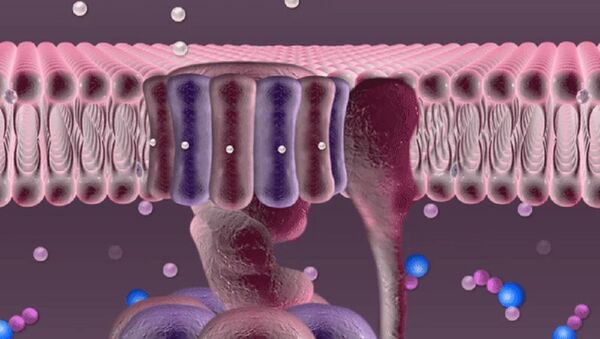Every second hundreds of trillions of mitochondria are buzzing with the roar of robotic devices running on proton power. Once released through a tiny hole, phosphate falls into a container, acquires new chemical properties through the electric current of protons and is then released through a pipe into the mitochondrion to join other phosphates in forming an ATP molecule.
How can this industrial process of sorts really be taking place in our body? Where do these "machines" in our cells come from? Where do the protons come from? Why do millions of these devices reminiscent of revolving doors inhabit our bodies?
Then glucose enters the cell. In the cell it breaks down in two parts, and at this stage (during which it is called pyruvate) it moves on to the mitochondrion.
Mitochondria are one of the main parts of the cells of most living organisms — animals, plants, fungi. According to one theory, mitochondria used to be independent organisms, which is why they have preserved their own genome (mitochondrial DNA). So inside every cell of every human are entities with their own genome! At some point, however, back in the ancient past, mitochondria merged with our cells, making it possible to turn food into energy. This fruitful, mutually beneficial cooperation is called symbiosis and continues to this day.
Upon entering the mitochondrion, pyruvates — products of glucose in the Krebs cycle — oxidize.
The mitochondrion also contains nicotinamide adenine dinucleotide (NAD). The energy released by oxidation detaches a proton from NAD.
"While moving about inside the mitochondrion, protons are surrounded with water," explained Sergei Akimov, research fellow at the NUST MISIS Department of Theoretical Physics and Quantum Technologies. "We know that a molecule of water is made up of two hydrogen (H1) atoms and one oxygen (O16) atom. Apart from forming chemical bonds within a molecule of water, these atoms can also form weak bonds with neighboring molecules called hydrogen bonds. Near the membrane surface these bonds in the molecules of water are formed in a different way, since there is water on one side and the ‘wall' on the other side. Hydrogen bonds formed near the membrane surface are different; they have a different bond number, a different structure. And protons use these bonds as "tracks" to move along the membrane. Our research proved that protons ‘like' this structure, they don't move towards the center of the mitochondrion, but rush along the membrane at abnormally high speeds."
That is how the cells get protons to synthesize ATP, the most important molecule that generates energy for our bodies. These molecules provide energy for our every move, maintain our body temperature and so forth. ATP are a sort of universal "battery" that provides energy for most of the reactions that take place inside the cell, enabling synthesis of proteins, carbohydrates and fats, the movement of flagella and cilia, substance transport and the disposal of cellular waste. Upon the breakdown of ATP — "battery" discharge — the body is provided with the necessary energy.
The results of this fundamental research bring scientists closer to understanding the global mechanisms of energy generation in cells, and open up new possibilities in pharmacology. The results of the research can be used to develop drugs that will neutralize the effects of uncoupling poisons and prevent hyperthyroid diseases. In bodies with these pathologies, mitochondria accumulate uncoupling agents — weak lipid soluble acids that effectively bind protons together, leading to an overall decrease in ATP synthesis. The new information acquired by Russian scientists will allow us to get closer to understanding what has to be done in order to replenish our energy at the level of every cell.






